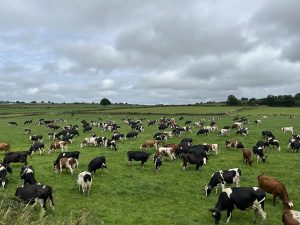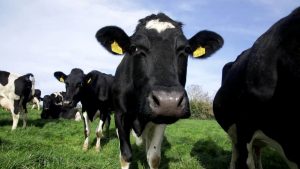
Understanding labour time use on dairy farms is key to identifying strategies to reduce labour demand and establishing sustainable workloads.
In recent years, Irish dairy farms have expanded to meet increased demand for dairy products, resulting in larger farms with greater requirements for labour input. Simultaneously, the number of people employed in agriculture has been in decline.
The issue of labour requirement and availability is exacerbated within pasture-based milk production systems; these systems are characterised by a compact calving pattern designed to maximise the utilisation of grazed grass. This creates an unbalanced workload over the seasons with 33% of total farm labour requirements occurring across three months in springtime.
The reduced availability of workers, combined with farmers placing increased emphasis on achieving a good work/life balance has led to work organisation and efficiency emerging as a priority research topic, particularly in pasture-based production systems.
“To achieve improved labour efficiency through better time use and productivity, a greater understanding of the peak workload on farms is required,” said Research Officer Marion Beecher. “While a number of studies have identified individual elements that could save time, the effect of these techniques, individually and in combination with labour demand, using real-time on-farm data, is unknown to-date.”
More in-depth examination could highlight the most effective strategies to reduce labour demand and guide farmers on decision-making.
In order to gather data, the research team recruited 76 farmers and their workers to record their labour time use. This was done using a smartphone application on one alternating day each week from the 1st February to 30th June 2019. This ensured that tasks completed routinely on an individual day were recorded, while at the same time, the recording would not be considered too inconvenient for the farmers involved. Contractors and any workers not using a smartphone recorded their labour input through an online form.
“Following the study, a variety of labour-saving techniques were implemented and work practices modified on many of the farms, mainly as a consequence of the labour data generated,” Marion said. These changes were recorded through a survey with the farmers involved. A subsequent recording of time use was conducted in the springtime of 2021 on 57 of those farms that made technology and/or work practice changes.
Labour efficiency improved as herd size increased, though there were large variations observed across farms, highlighting both highly efficient farms and farms with scope for improvement. However, herd size did not impede farmers in being labour-efficient; highly labour-efficient farms were observed with small and large cow herds.
In the 2019 study, farmers worked on average 60 hours/week from February to June, while milking (31%) and calf care (14%) were the most time-consuming tasks.
Using the longitudinal data of 2019 to 2021, positive effects on labour efficiency were seen through the implementation of new facilities, technologies and work practices – such as milking parlours and automatic calf feeders. As a result, total labour efficiency improved by 7% – equivalent to 0.7 hours/cow over the five-month data recording period.
A holistic approach to efficiency
The research identified 59 work practices and technologies as being associated with labour efficiency. On average, farms implemented 31 of these labour-efficient work practices and technologies.
“Using an accumulation technique to identify and estimate the effects of labour-saving practices and technologies was a novel aspect of the study, allowing us a more holistic approach,” explained Marion.
“Previous studies hand-picked a selection of work practices or technologies implemented on the most labour-efficient farms, whereas this study incorporated all work practices and technologies before removing those not associated with labour efficiency. This removed any potential bias regarding the selection of labour-efficient work practices and technologies.”
A further novel aspect of this study was the development of a framework to measure farm work organisation effectiveness using the time-use data collected.
“Studying work organisation in other industries and within agriculture allowed us to identify three key characteristics or measures of work organisation: efficiency and productivity, flexibility and standardisation,” Marion said.
Work efficiency and productivity are key characteristics of any work system, focusing on maximising the output from inputted labour without negatively affecting work quality. Flexibility is important in terms of achieving a balance between work and personal life. This can be challenging on farms due to the repetitive nature of tasks such as milking and calf care; the consequent effects of which mean farmers often work seven days per week. Standardisation refers to the sequence and structure of tasks to ensure high standards of work quality. These three characteristics were measured in terms of farm hours worked per cow and farmer hours worked per day; length of the farmers’ working day and the number of days off; number of different tasks completed by the farmer per day and the finish time of the farmer.
The top 25% of farms in terms of work organisation effectiveness had better labour efficiency, lower labour input, shorter work days and earlier finishing times than the bottom 25% of farms. Some of the savings in hours worked were likely due to those farms having labour-saving facilities, technologies and work practices as well as effective work organisation. Improvements in work organisation can have positive outcomes for job satisfaction and optimise business performance, particularly through improved labour productivity and efficiency.
“Our study has shown that dairy farming systems can be sustainable in terms of labour demand and input,” Marion added. “The adoption of different strategies with respect to farm facilities, work practices, technologies, work organisation or a combination can allow farmers to make logical decisions to address their given labour challenges.”
Placing greater value on the sustainability of workload will be essential for future dairy farming systems. The positive cases observed in terms of farmer working hours and the potential flexibility of the dairy farming workload should be highlighted; both to address the negative perceptions associated with careers in dairy farming and to show farmers what can be achieved on their own farms.
Funding
This project is funded by Teagasc’s Walsh Scholarship Programme and Dairy Research Ireland.
Contributors
- Conor Hogan, People in Dairy Programme Manager, Teagasc Moorepark.
- Bernadette O’Brien, Principal Research Officer, Teagasc Moorepark.
- Marion Beecher, Research Officer, Teagasc Moorepark.Email: marion.beecher@teagasc.ie
Further Information
Read these published research papers from the team:
An examination of labor time-use on spring-calving dairy farms in Ireland
The impact of work organisation on the work life of people on pasture-based dairy farms
This article first appeared in the Autumn edition of TResearch. Access the full publication here.

























